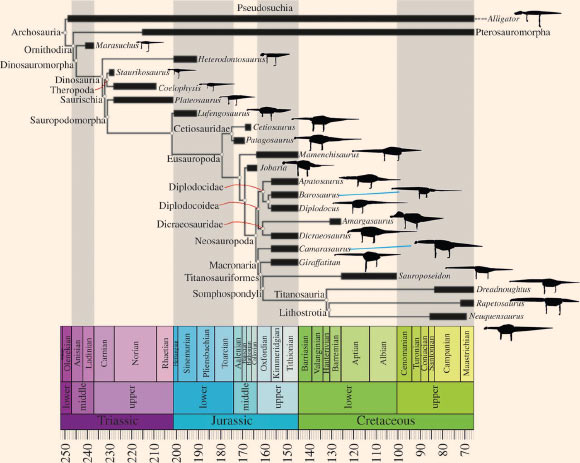A large team of paleontologists led by University of Liverpool scientist Dr. Karl Bates has developed computer models of the bodies of sauropod dinosaurs to examine the evolution of their body shape.

An artist’s recreation of Giraffatitan (foreground), a sauropod dinosaur that lived during the Jurassic period. Image credit: Dmitry Bogdanov / Gerhard Boeggemann / Sci-News.com.
Sauropod dinosaurs were the dominant group of large herbivores in global terrestrial ecosystems throughout much of the Mesozoic era. Some of the more well-known sauropods include Diplodocus, Brontosaurus and Giraffatitan.
Their colossal size and body plan are unparalleled in terrestrial vertebrates. They are renowned for their very long necks, long tails as well as four thick, pillar-like legs and small heads in relation to their body.
However, to date, there have been only limited attempts to examine how this unique body-plan evolved and how it might be related to their gigantic body size.
Dr. Bates and co-authors used three-dimensional computer models reconstructing the bodies of sauropod dinosaurs to analyze how their size, shape and weight-distribution evolved over time.
“We combine three-dimensional computational models with phylogenetic reconstructions to quantify the evolution of whole-body shape and body segment properties across the sauropod radiation,” the scientists said.

Time-calibrated phylogeny showing sauropod dinosaur species included in this study, with silhouettes of the convex hull volumetric models in left lateral view (silhouettes not to scale). Image credit: Karl T. Bates et al.
They found evidence that changes in body shape coincided with major events in sauropod evolutionary history such as the rise of the titanosaurs.
The early dinosaurs that sauropods evolved from were small and walked on two legs, with long tails, small chests and small forelimbs.
The paleontologists estimate that this body shape concentrated their weight close to the hip joint, which would have helped them balance while walking bipedally on their hind legs.
As sauropods evolved they gradually altered both their size and shape from this ancestral template, becoming not only significantly larger and heavier, but also gaining a proportionally larger chest, forelimbs and in particular a dramatically larger neck.
The findings, published online in the journal Royal Society Open Science, show that these changes altered sauropods’ weight distribution as they grew in size, gradually shifting from being tail-heavy, two-legged animals to being front-heavy, four-legged animals, such as the large, fully quadrupedal Jurassic sauropods Diplodocus and Apatosaurus.
Dr. Bates and his colleagues found that these linked trends in size, body shape and weight distribution did not end with the evolution of fully quadrupedal sauropods.
In the Cretaceous period – the last of the three ages of the dinosaurs – many earlier sauropod groups dwindled.
In their place, a new and extremely large type of sauropod known as titanosaurs evolved, including the truly massive Argentinosaurus and Dreadnoughtus, among the largest known animals ever to have lived.
_____
Karl T. Bates et al. 2016. Temporal and phylogenetic evolution of the sauropod dinosaur body plan. R. Soc. open sci. 3: 15063; doi: 10.1098/rsos.150636







